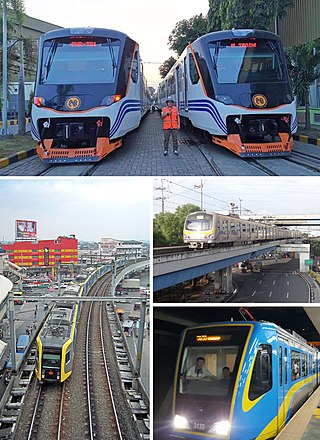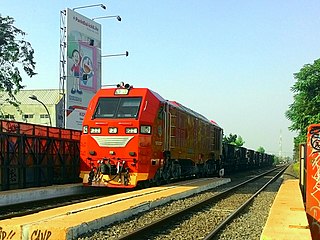
The Philippine National Railways (PNR) is a state-owned railway company in the Philippines which operates one commuter rail service between Laguna and Quezon, and local services between Sipocot, Naga and Legazpi in the Bicol Region. It is an attached agency of the Department of Transportation.

Rail transportation in the Philippines is currently used mostly to transport passengers within Metro Manila and provinces of Laguna and Quezon, as well as a commuter service in the Bicol Region. Freight transport services once operated in the country, but these services were halted. However, there are plans to restore old freight services and build new lines. From a peak of 1,100 kilometers (680 mi), the country currently has a railway footprint of 533.14 kilometers (331.28 mi), of which only 129.85 kilometers (80.69 mi) are operational as of 2025, including all the urban rail lines. World War II, natural calamities, underspending, and neglect have all contributed to the decline of the Philippine railway network. In the 2019 Global Competitiveness Report, the Philippines has the lowest efficiency score among other Asian countries in terms of efficiency of train services, receiving a score of 2.4, and ranking 86th out of 101 countries globally. The government is currently expanding the railway network up to 1,900 kilometers (1,200 mi) by 2022 through numerous projects.

Lucena station is a railway station located on the South Main Line in Lucena, Quezon, Philippines.

Calamba station is a railway station located on the South Main Line in Laguna, Philippines. It is one of two railway stations in the city and it is a major station on the line, serving as the junction between the South Main Line and the old Calamba–Batangas branch line which used to connect to Batangas City. It is also envisioned to be the terminus of the Commuter Express when rehabilitation work is complete. The station was first opened on January 24, 1909.

San Pablo station is a railway station located on the South Main Line in San Pablo, Laguna, Philippines.

Legazpi station is the current railway terminus of the South Main Line located in Albay, Philippines. It is also the terminus for the Legaspi-Tabaco branch line. The station is currently used for the Bicol Commuter rail.

The PNR Metro Commuter Line was a commuter rail line operated by the Philippine National Railways. It was first inaugurated as the Metro Manila Commuter Service in 1970, and originally served the North Main Line and the South Main Lines, as well as the defunct Carmona and Guadalupe branch lines. Since then, it adopted several names such as Metrotrak and Metrotren, before adopting its present name in the late 2000s. The line was also nicknamed the Orange Line due to its designation in the 1970s.

The North–South Commuter Railway, also known as the Clark–Calamba Railway, is a 147-kilometer (91-mile) commuter rail system under construction on the island of Luzon in the Philippines. Running from New Clark City in Capas, Tarlac, to Calamba, Laguna, with 36 stations and four services, the railway is designed to improve connectivity within the Greater Manila Area and will be integrated with the railway network in the region.
Gulod station is a proposed railway station located on the South Main Line in Laguna, Philippines. It is planned to be situated in between the existing Cabuyao and Mamatid stations. This PNR station is proposed by the JICA for both the current Metro Commuter and the South Line of the North-South Commuter Rail Project.
Pansol station is a railway station located on the South Main Line in Calamba, Laguna, Philippines. The station once had a rail yard with four tracks. The single main line track had a long passing loop that contained another, shorter passing loop. It also contained a refuge which led to a ballast pit. The station is 60 km from Tutuban.
IRRI station is a railway station located on the South Main Line in Los Baños, Laguna, Philippines. It is a flag stop for the line as there are no platforms yet being erected, temporary stairs for the trains are added in the meantime to facilitate loading and unloading.

The PNR 8000 class is a diesel multiple unit (DMU) train operated by the Philippine National Railways (PNR) since 2019.

The PNR South Main Line is one of the two trunk lines that form the Philippine National Railways' network in the island of Luzon, Philippines. It was opened in stages between 1916 and 1938 by the Manila Railroad. Services peaked in the 1940s until the late 1960s, when the system started to decline. Since 1988, it was the only functioning inter-city rail after its counterpart to the north, the North Main Line, was closed. The intercity section of the line in Laguna, Quezon and the Bicol Region was then closed and reopened repeatedly between 2004 and 2014 due to a combination of declining ridership and was closed since then. Currently, only a little more than half of line is operational as the line currently serves two commuter services, namely the Inter-Provincial Commuter from San Pedro to Lucena and the Bicol Commuter regional rail service between Sipocot, Naga Camarines Sur and Legazpi Albay, following the closure of the main line, the PNR Metro Commuter Line between Tutuban station and Laguna.
Los Baños station is a railway station located on the South Main Line in Los Baños, Laguna, Philippines.
College Station is a railway station located on the South Main Line in Los Baños, Laguna, Philippines.

The INKA CC300, also known in the Philippines as the PNR 9000 Class, is a multipurpose Diesel-hydraulic locomotive owned by Directorate General of Railways and built by Indonesian state-owned rolling stock manufacturer PT INKA. Launched in 2013, it is the first mainline locomotive wholly produced by Indonesia and the first locomotive exported by Indonesia to another country, when the Philippine National Railways (PNR) received its first set of INKA CC300 locomotives in December 2020.

The PNR South Long Haul, also known as the PNR Bicol, was a proposed inter-city rail line project in southern Luzon, Philippines. It is part of the larger Luzon Rail System, a network of long-distance standard-gauge lines being built by the Philippine National Railways throughout Luzon. It is one of the two lines that will reconstruct the historic PNR South Main Line, along with the electrified North–South Commuter Railway South section to Calamba, Laguna.

Rail transportation in the Greater Manila Area is a major part of the transportation system in Metro Manila and its surrounding areas. The railway network, collectively known as the Greater Capital Region Railway System, consists of the Manila Light Rail Transit System (LRT), Manila Metro Rail Transit System (MRT), and Philippine National Railways lines within the region.
















